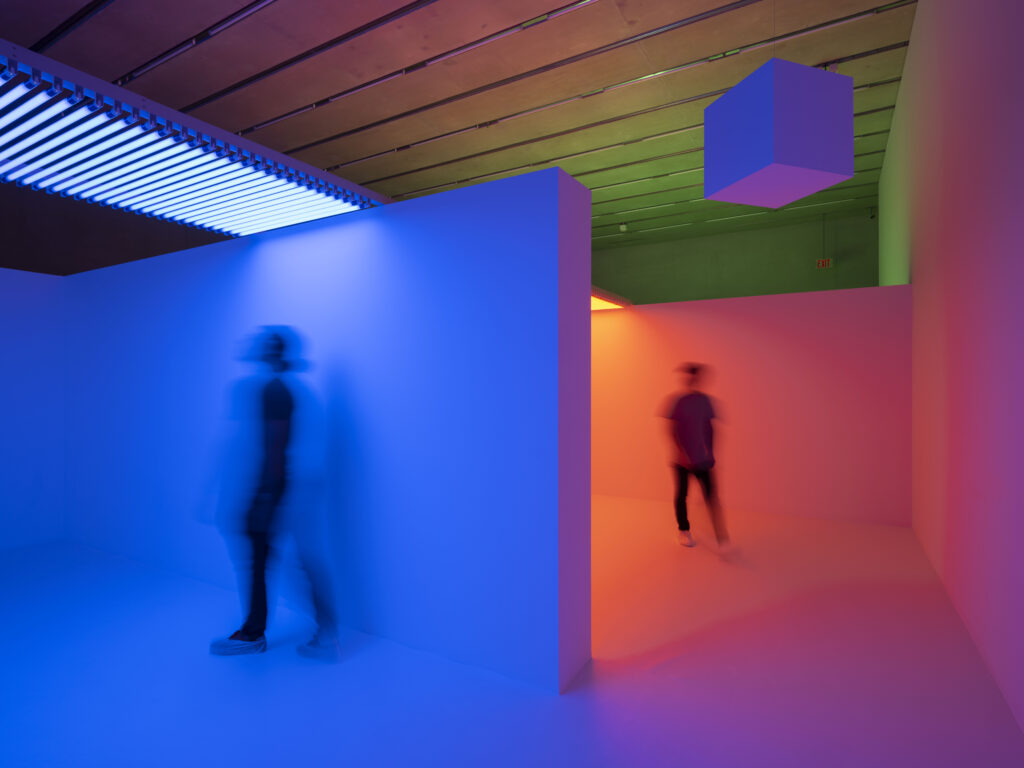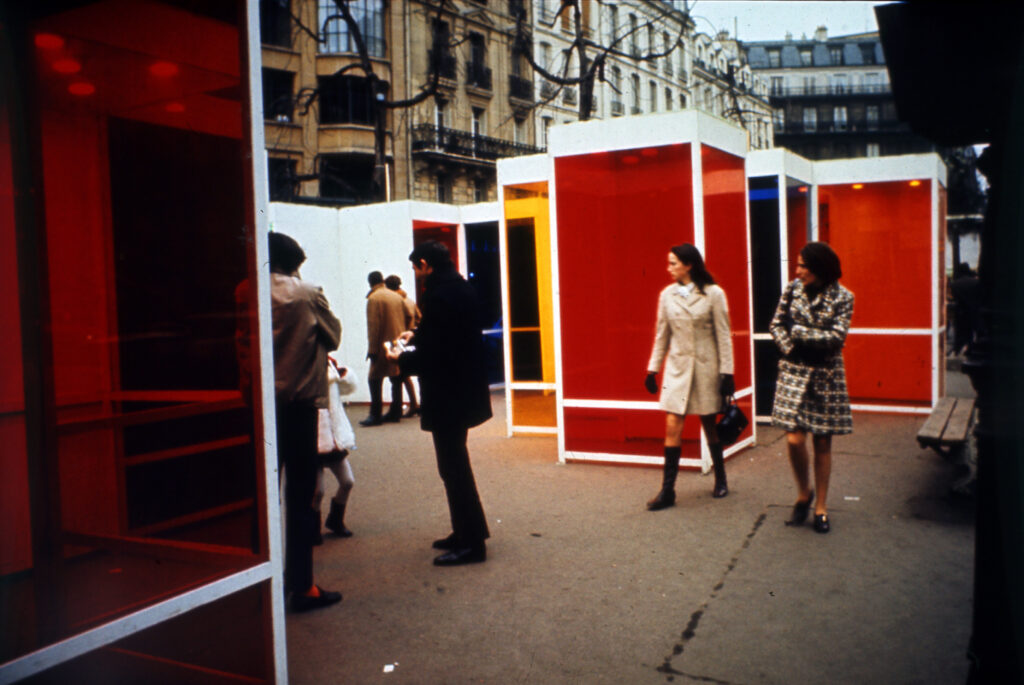Carlos Cruz-Diez: Chromosaturation
October 2, 2025 – September 27, 2026
Carlos Cruz-Diez (b. 1923, Caracas; d. 2019, Paris) is a central figure in the history of late 20th-century art. His investigations into the ephemeral and ever-changing nature of color positioned him as a pioneer of kinetic and Op art. Through his experimental use of light, movement, space, and viewer participation, Cruz-Diez challenged static notions of visual art, encouraging what he described as “an awareness of the instability of reality” and advancing a new vision of art as an active, perceptual encounter.

Chromosaturation is an immersive installation that reimagines color as a lived, bodily experience. Conceived in 1965, the work comprises three interconnected chambers, each illuminated in a single hue: red, green, or blue. Immersed in this monochrome environment, the viewer experiences a kind of retinal overload, confronting the limits of visual perception. The work underscores color as an inherent property of light––a physical, temporal phenomenon that unfolds in real time as the viewer moves through the space.
By reimagining color as an embodied encounter, Chromosaturation exemplifies Cruz-Diez’s vital role in the experimental practices of the 1960s and ’70s, which shifted the focus from static art objects to participatory situations that engage the body, the senses, and subjective experience. His radical approach to perception anticipated the immersive and experiential strategies that define much of contemporary art today.
Organization and Support
Carlos Cruz-Diez: Chromosaturation is organized by Iberia Pérez González, PAMM’s Andrew W. Mellon Caribbean Cultural Institute Curatorial Associate.
Over more than seven decades, Carlos Cruz-Diez (b. 1923, Caracas; d. 2019, Paris) developed a distinctive visual language based in color and viewer participation. Driven by the need to renew the seemingly exhausted field of painting, Cruz-Diez aimed at liberating color from its material support to generate a chromatic experience that goes beyond the mere act of passive contemplation. His groundbreaking pictorial concepts pushed the boundaries of painting, highlighting color not as pigment fixed on the surface of a canvas, but rather as a dynamic, unstable phenomenon in continuous transformation.
Through his experimental use of light, movement, space, and viewer interactivity, Cruz-Diez explored the perception of color as an autonomous reality evolving in space and time. His extensive body of work considers color as an experience in itself, a “chromatic event” occurring in the present, free from preconceived meanings. Cruz-Diez’s systematic explorations into the ever-changing and ephemeral nature of color established him as a pioneer of Kinetic and Op art—two international art movements that emerged in the mid-20th century with a focus on visual perception and the spectator’s active engagement with the work of art.
Initially conceived in 1965 and presented for the first time in 1968, the Chromosaturation marks a turning point in Cruz-Diez’s career, representing the moment when the artist fully transposed his pictorial investigations into three-dimensional space. This work exemplifies Cruz-Diez’s most accomplished effort at projecting color into space as a participatory event. The installation consists of three connected chambers infused with intensely saturated red, green, and blue—the primary colors of light. The uncanniness of the experience is related to the fact that the viewer is immersed in a single color. This absolute monochrome situation overloads the retina, which is normally accustomed to perceiving a wide range of colors simultaneously. As the viewer moves through the installation, the color that dominates each chamber blends seamlessly with the next, producing a sublime gradient at every threshold. The suspended cubes—the sides of which are bathed in reflected color—heighten the viewer’s experience and showcase the vibrancy of an environment entirely free of form and meaning. Emphasizing color as an inherent property of light, the artwork transitions from a visual experience into a bodily one, underscoring the notion of color as a material, physical phenomenon that unfolds continuously in space and time.

Chromosaturation is one of eight lines of research making up Cruz-Diez’s visual discourse on color. The earliest mock-up of the work was created in the mid-1960s and consisted of a tunnel or walkway made with transparent red, blue, and green plexiglass walls. Its location in the public space permitted a view of the surrounding environment, prompting a dialogue between spectators inside the artwork and those observing it from the outside. Since then, different configurations of Chromosaturation have been exhibited all over the world in both interior and exterior spaces. Despite slight variations, every solution devised by the artist has the same goal: to employ pure color as the spatial infrastructure to elicit an intense sensorial and emotional response in viewers. Chromosaturation reimagines color as an embodied experience in which visitors become active participants in the work of art, rather than mere onlookers. Cruz-Diez’s explorations into the potential of audience interaction through the integration of color into the architectural environment can be traced back to the mural designs he created in the early 1950s. These outdoor murals, which included colored geometric pieces that could be manipulated by viewers, would change depending on the passing of daylight; this would produce a visual interplay between the shadows and bright reflections of color on the wall, subject to time and movement.
Cruz-Diez’s Chromosaturation can be understood as an open artwork or, in the words of art historian Ariel Jiménez, a “penetrable painting” that is completed only through the viewer’s engagement. Cruz-Diez’s explorations of this important concept represent early manifestations of a lineage that proved highly influential for contemporary art and culture, involving the dematerialization of the self-contained object in favor of the immersive, experiential installation. While this lineage of participatory situations that engage the viewer’s body, senses, and subjectivity emerged transnationally—appearing in the work of roughly contemporaneous artists such as Allan Kaprow and Yayoi Kusama—the contribution of artists from Latin America is strikingly notable. This can be seen, for example, in Jesús Rafael Soto’s large-scale interactive penetrable sculpture Penetrable BBL Blue (1999), which is on display outdoors on Pérez Art Museum Miami’s west portico. Enveloping participants in a field of suspended blue rods, Soto’s Penetrable foregrounds spatial vibration and introduces the sense of touch to the experience of immersion, while Cruz-Diez’s Chromosaturation emphasizes the physiological and temporal dimensions of color. Together, these works challenge the notion of static viewing and propose an art of participation and sensory transformation.
Chromosaturation—particularly early versions of it—is also considered a precursor to the initial experimental light installations of artists such as Robert Irwin and James Turrell, who are associated with the Light and Space movement. Immersive, multisensory installations such as these have, since then, become a regular part of the arsenal that contemporary artists deploy to generate new experiences that disrupt everyday reality. In this way, they prompt us to envision the world otherwise.
Biography
Carlos Cruz-Diez graduated from the School of Fine Arts in Caracas, Venezuela, in 1945. Since then, his paintings, chromatic environments, large-scale public art projects, and architectural interventions have been exhibited worldwide. Solo exhibitions of his work have been presented at the Museo de Bellas Artes de Caracas, Museo Nacional Centro de Arte Reina Sofía in Madrid, Museo de Arte Contemporáneo in Panamá City, Museo de Arte Latinoamericano de Buenos Aires, Museum für Konkrete Kunst in Ingolstadt, Palais de Iéna in Paris, Americas Society in New York, and Central Academy of Fine Arts (CAFA) in Beijing. Cruz-Diez participated in numerous group exhibitions, including at the Cleveland Museum of Art, Denver Art Museum, Fundación Juan March in Madrid, Musée d’Art Moderne de Paris, Museum of Contemporary Art in Los Angeles, Moderna Museet in Stockholm, Stedelijk Museum Schiedam, Garage Museum of Contemporary Art in Moscow, Venice Biennale, and El Museo del Barrio in New York, among others. Cruz-Diez was the recipient of numerous honors and awards, and his work can be found in major public collections including the Museum of Modern Art in New York, Tate Modern in London, Musée d’Art Moderne de Paris, Centre Pompidou in Paris, Wallraf-Richartz Museum in Cologne, Museum of Fine Arts, Houston, and Pérez Art Museum Miami.
Organization and Support
Carlos Cruz-Diez: Chromosaturation is organized by Iberia Pérez González, PAMM’s Andrew W. Mellon Caribbean Cultural Institute Curatorial Associate.




